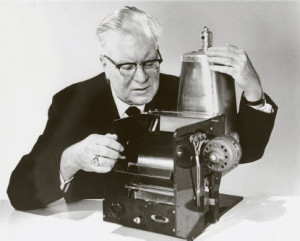Ok, c’mon, let’s face it, we’ve all taken a walk on the wild side and made a copy of our hands, feet and faces. (ok, gasp!, our derrieres too?) However, long before it was possible to climb upon the glass exposing our … uh, well, the first demonstration occurred in 1938.
 October 22 marks the day in 1938 when physicist Chester Carlson introduced his invention of the xerographic process. However, for as much as we depend on the process now-a-days and likely could not imagine life without a copy machine, Chester’s idea didn’t always delight.
October 22 marks the day in 1938 when physicist Chester Carlson introduced his invention of the xerographic process. However, for as much as we depend on the process now-a-days and likely could not imagine life without a copy machine, Chester’s idea didn’t always delight.
Carlson’s ingenuity, which launched what is today a multi-billion dollar industry didn’t fare well at first: “for several years after patenting his process, Carlson could find no company interested in xerography. It was the invention that nobody wanted,” said aps.org.
“[Carlson] developed much of his patience and perseverance during an especially difficult childhood. Born in Seattle, WA, in 1906, Carlson was the only child of an itinerant barber and grew up in southern California. By age 14 he was working after school and weekends for a local printer to support the family, since his father was crippled from arthritis. His mother succumbed to tuberculosis when he was 17. Always fascinated by graphic arts and chemistry, Carlson didn’t let his humble roots deter him from finishing high school and working his way through a nearby junior college, earning a degree in chemistry. He then attended Caltech, graduating two years later with a degree in physics, “ it said.
“Unfortunately, Carlson entered the job market in the midst of the Depression, applying to 82 firms before landing a job as a research engineer at Bell Telephone Laboratories in New York City. His success was short lived and he was soon laid off because of the deepening Depression, finally securing a position with an electronics firm, P.R. Mallory & Co. He studied law at night at the New York Law School, and eventually became manager of the company’s patent department. Despite the security of a steady job in uncertain times, Carlson was dissatisfied and restless, and devoted his leisure hours to the pursuit of invention.”
Lucky for the guy named Chester, he noticed things and, it was around this time he paid particular attention to the fact that there never seemed to be “enough copies of patent specifications”
Chester Carlson was left with just two options.
Apparently and luckily [for all of the] backsides across America, the big pond and beyond, he chose the correct one: the first xerographic copy was made on October 22, 1938.
Yes, “Sometimes it takes extraordinary patience, perseverance, and belief in oneself before the usefulness of an invention is finally realized.”
